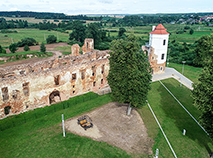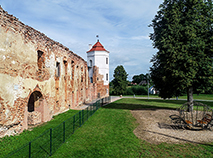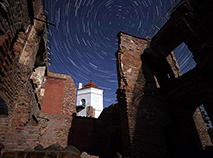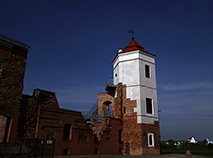Golshany Castle

Built in the first half of the 17th century, Golshany Castle is one of the most mystical places in Belarus. Once it was a residence of the influential Sapieha family. In the 20th century it served as a source of inspiration for the famous detective story The Black Castle of Olshany by renowned Belarusian writer Vladimir Korotkevich.
History of Golshany Castle

The castle, or what has survived of it, is located in the agro-town of Golshany, Oshmyany District.
The town of Golshany was first mentioned in chronicles in the 13th century. Back then it was a wooden castle built on the instruction of Prince Golsha on the hill above the Korabl (Korabel) River. His descendants, princes of Golshany (or Olshany), owned these lands until the middle of the 16th century.
After the death of the last male representative of the Golshany family Semyon Yurievich, the estate together with the castle was passed as a dowry to the new owners - Princess Alena of Golshany and her husband Pavel Stefan Sapieha, vice-chancellor of the Grand Duchy of Litva (Lithuania) and cousin of the famous chancellor Lev Sapieha. The Sapiehas had the family residence moved to the bank of the Lusta River (its other historical names were Zhigyanka, Vyshnevka, today - Olshanka or Golshanka).

A new stone castle was built in the first half of the 17th century. Compositionally, it resembled the castle in the town of Mir and was of a rectangular closed shape with sides of almost 100m by 90m. But here, unlike Mir Castle, the defense rested on towers, earthen ramparts and water moats surrounding the castle. Thick walls were replaced by the facade of a residential building. The towers were made less massive, with their defensive value intact. In addition, they housed residential and utility rooms.
The entrance to the castle (brama) was located in the center of the north-eastern facade. The walls of the fortress had ornamented masonry with stucco and large windows. On the second floor of the north-eastern building there was an open-air gallery facing the courtyard.
The wealth and ambitions of Pavel Sapieha turned Golshany Castle into one of the best architectural and economic complexes of its time. Inside, the castle was richly decorated: paintings on the walls, tiled stoves, stucco molding on the ceiling and fireplaces. The building had unique heating, water supply and sewerage systems.

Under the two floors there were six cellars, each of which had its own purpose - beer, honey, wine. The castle had a malt house, a brewery, a kitchen with a baker's facility, a bathhouse, a zeichhaus, a house of guards and estate manager, a prison and other facilities for the autonomous life of the residence.
Near the castle, there were three beautiful man-made lakes. A legend has it that the bottom of each of them was tiled. Yet it is impossible to confirm this legend today. Not far from his residence, Pavel Sapieha ordered the construction of a church and a Franciscan monastery.
Over time, the castle was repeatedly destroyed and rebuilt. As a result of archaeological digs in 1981-1983, experts identified three stages of construction, which differed in the type of bricks, lime mortars and the method of masonry.

After the death of Pavel Sapieha at the end of the 17th century, Golshany Castle passed to new owners, and then changed hands more than once. In 1880, the owner decided that such a large castle was useless, and destroyed part of the towers and walls, and sold the brick for the construction of a tavern.
The castle was still habitable till 1939. After the Great Patriotic War the surviving premises were dismantled to use building materials to build a community center and a farm.
By the beginning of the 21st century, only the skeleton of the once magnificent castle survived. Local residents dismantled the walls, brick by brick, for construction needs. Many houses in Golshany were built using the bricks "with a finger stamp", i.e. with the imprint of the master's hand. By the way, the town itself, that still has the layout of a medieval town, is perhaps the most colorful in Belarus.

Interestingly, the monastery with the church erected by order of Pavel Sapieha survived. In the late 18th century they underwent significant changes compared to the original project, but since then they have remained unchanged and survived till our days almost in the authentic form.
There are a lot of mysterious stories about Golshany Castle, although, interestingly, they came to life in the 19th -20th centuries. ... It is said that the ghosts of the Black Monk and the White Lady are sometimes spotted on the ruins. One of the legends has it that centuries ago there lived a beautiful princess in the castle and she fell in love with a young commoner. The feelings were mutual. But somebody spilled the secret to the father of the girl, who ... ordered to have both of them walled up in the castle. Since that time, the restless souls of the Black Monk and the White Lady have been wandering around the ruins…
Did you know that...
Representatives of the families that owned Golshany held high positions in the state and beautiful ladies won the hearts of famous men. For example, Ulyana of Golshany was the wife of Prince Vitaut, and Sophia of Golshany became the wife of King Jahajla and they started the famous royal dynasty of the Jagiellonians.
The first national musical "Sophia of Golshany" to the music of composer Vladimir Kondrusevich premiered in Belarus in 2013. Today this romantic melodrama is still on the playbill of Belarusian State Academic Musical Theater.
Golshany Castle today

For a long time, only the remains of the ancient walls and towers reminded of the former grandeur of the Sapieha residence. They were mothballed in the 2010s and a restoration project began in 2017. Golshany Castle is gradually coming back to life, and in 2021 it officially opened to tourists.
The restored Northern Tower is now available for the public. A museum exposition with valuable artifacts opened there. Each tier has its own concept. The exposition in the basement immerses visitors into the mystery and legends of Oshmyany District and Golshany Castle. The exposition on another floor displays rarities found during archaeological digs at the castle and around it undertaken at different times. The utility room and the main hall with a fireplace were also restored.
The upper tier of the tower has an observation deck that offers a beautiful view of Golshany. Here one can see a mockup of the castle, drawings depicting how it looked through the years, portraits of the owners.

The area near the castle was fitted with the necessary tourist infrastructure - a tourist center with a souvenir shop, administrative and sanitary premises, and parking.
Even before the beginning of the restoration project, Golshany Castle was known as a venue for a medieval culture festival held once a year. After the castle opened to tourists, the number of events increased. Among them are “The night of museums near the walls of Golshany Castle”, “Reception at Sophia of Golshany”.
Father Frost’s New Year Residence opened in the castle in December 2021. Visitors to the residence could see fairytale characters and personalities from the past - King Jahajla and his wife Sophia of Golshany, as well as the mythical White Lady. Visitors could receive a painted Golshany gingerbread baked according to an old recipe as a souvenir. It is believed that the owner of the castle, Pavel Sapieha, treated his guests to such gingerbread. Golshany might become a permanent winter residence of Father Frost.
Transport and accommodation

Golshany is located in Oshmyany District, Grodno Oblast. It is about a 130km drive from Minsk. The most convenient way to get there by car is to use the M6 highway that will take you to the village of Sharai where you should take the E28 / M7 road. At the junction near the town of Krevo famous for the ruins of Krevo Castle, you need to turn left onto the P95 road. Soon you will see the sign showing the direction of the Sapieha residence in Golshany. Coordinates: 54.251389, 26.020278.
You can stay at the Castle Hotel located in the merchants’ building in the center of Golshany.
Tourist attractions near Golshany Castle
Many interesting sights have survived in the north-west of Belarus where Golshany is located. For example, on the way to the Sapieha residence, you can see the ruins of the famous Krevo Castle and the former Basilian monastery in the village of Boruny.
The town of Golshany has quite a fascinating history. There is a historical quarter consisting of old brick houses in the center, most of which date back to the late 19th – early 20th centuries. The shopping stalls on the main square are also impressive. The town’s main attractions include the St. John the Baptist Church and the former monastery of the Franciscan Order built under Sapieha.
It is noteworthy that another explanation of the legend about the White Lady has to do with the Franciscan church. ... During the construction of the temple, several walls collapsed. Fearful of the owner’s anger the workers needed to find a way to stop the the walls from falling. So they decided to make a sacrifice - the first woman who would bring dinner to her husband would be walled up in the castle. It was a young wife of a bricklayer who was sacrificed. Since then, the ghost of the unfortunate woman in white robes is said to have been wandering around the neighborhood ...
The main Orthodox temple of Golshany – St. George Church – was built in 1901. The parish itself has been known since the 13th century, but the ancient wooden churches that dilapidated and replaced each other, have not survived to this day.
On the way to the castle you will see an interesting wooden building that once housed the local administration. It was built in 1928 in the Art Nouveau style with elements of Neoclassicism. Now it is a small hotel where you can feel the spirit of those times.
The village of Traby located not far from Golshany is also worth visiting for the Church of the Nativity of the Virgin Mary built of stone in the early 20th century and the Peter and Paul Church built of wood in 1784. The latter has preserved in a very good shape.



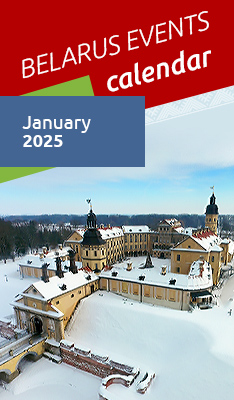




 print version
print version make home page
make home page add to bookmarks
add to bookmarks

